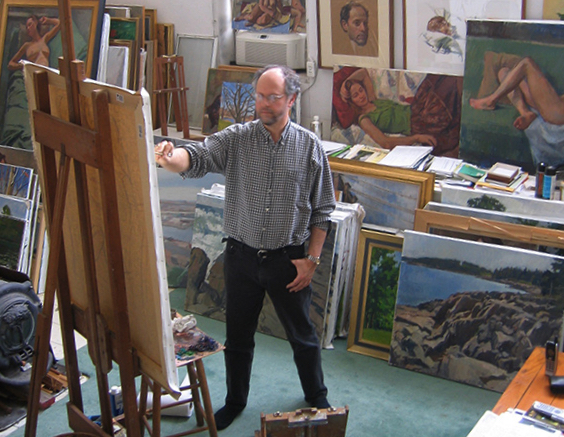
In 1934, when my father, Morris Weiss, was an aspiring cartoonist of nineteen, he visited his idol, James Montgomery Flagg. Flagg’s apartment was just a few minutes from the League, in the Parc Vendome at the corner of 57th Street and Ninth Avenue. In addition to illustrating for magazines and painting the occasional high-level portrait, Flagg turned out charcoal portraits of movie stars of the era, many of whom were his friends. My father was honored when arguably the most famous illustrator of the time sat him down and drew his portrait. The portrait, which well captured my dad’s physical presence as well as his self-confidence, was drawn in less than a half-hour. Flagg also inscribed one of his large pen-and-ink illustrations to my father. Later, his bravura technique influenced my youthful attempts in the medium.
Everett Raymond Kinstler began as a cartoonist, before he became one of the preeminent portrait painters of his generation. He was Flagg’s confidante late in life and adopted some of his mentor’s mannerisms in the handling of various media—the similarities are particularly noticeable in his charcoal portraits, including the signature he used. It was inevitable that my father would eventually correspond with Kinstler. I was not privy to their phone calls, but with Flagg as the central figure, they would have had a lot to talk about.
As I write, I realize my connections are yet more complicated, and a pleasant detour is required. I got to know the sculptor Elisabeth Gordon Chandler when I started teaching in Old Lyme in the 1990s; Elisabeth founded the Lyme Academy, and on occasion would invite me to her home for tea. Years earlier, she had a New York studio in the same building as Flagg. One day she asked to sculpt his portrait, and he consented to sit. She made a powerful image, which was cast in bronze. About twenty years ago Kinstler painted Elisabeth’s portrait, and referenced their shared fondness for Flagg by including the bronze portrait Elisabeth had sculpted. It was just over life size. I know this, because after Elisabeth died in 2006, I purchased that sculpture. A few years ago I gave it to the National Museum of American Illustration.
I knew Mr. Kinstler first through my father, and then when we crossed paths in New York City. He once welcomed me to his studio on Gramercy Park to talk about the business of portraiture and advised me to paint a few portraits of judges; I suppose the robes lend gravitas and an official imprimatur to a painter’s efforts. Once he called unexpectedly to tell me that a midtown gallery was looking at the work of new artists. We met later in Old Lyme, when Ray was teaching a workshop at the Lyme Academy, and he returned when the Academy presented him with an honorary degree. It seemed he was always surrounded by admirers. I think of him as immensely comfortable in his skin as a public figure, and think that Flagg and my father, extroverts all, were similarly gifted.
The last time I saw Ray Kinstler was in 2016, when he warmly eulogized David Pena at a service in midtown Manhattan. I had known Dave since we were students at the League in the late 1970s. Later, I shared a studio in the same building where he was ensconced. We spent many hours together talking and breaking bread, and he sat for me several times. Later still, Dave was a workshop assistant for Kinstler. Something of Flagg’s flamboyance and Kinstler’s facility were present in Dave’s work, and in his youth he looked like a throwback, with a bit of Errol Flynn about him. By the way, everyone I mentioned—my father, Flagg, Kinstler, Elisabeth, Dave and myself—studied or taught at the Art Students League.
Jerry Weiss’s Portrait of Dave Pena will be on view from February 10 through March 29, 2020.




